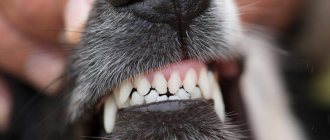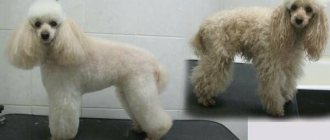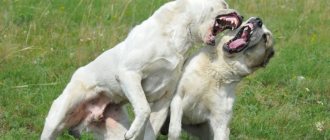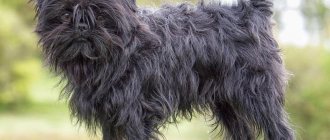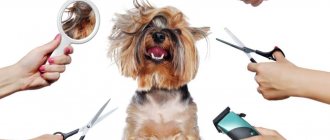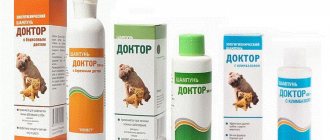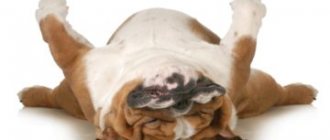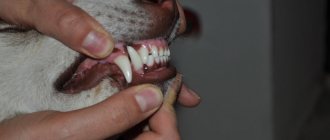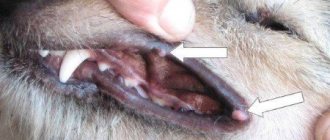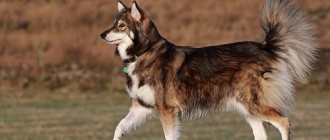A dog's teeth are of particular importance. It is snow-white, healthy and strong fangs that are the key to a dog’s excellent appetite, ideal digestion, and, as a result, excellent health. Direct bite in dogs is also of unconditional importance - it is this sign of health that will be discussed in the article. We will find out how important it is for a dog to form a correct bite, learn the main types of bites, and figure out how to correct improper jaw closure.
Correct bite. Snack. Underbite.
Bite in dogs is the relationship between the dentition of the upper and lower jaw. The type of bite in a dog is determined by the nature of the closure of the dentition and can be of four types: scissor-shaped (“scissors”), straight (“pincers”), overshot, undershot. The bites listed above depend on the length and position of the jaws. In addition, the bite can change for various reasons, and be, for example, floating (a temporary phenomenon in puppies due to a soft, undeveloped jaw), skewed (improper tooth growth, trauma, congenital anomalies) or alveolar (improper inclination of the teeth) .
Chinese crested bite
The normal bite of a Chinese Crested dog is described by the standard as a scissor bite (or, as dog lovers call it, “scissors”). With this type of bite, the upper canines slightly cover the lower ones. In this case, the lower canines should enter the interdental space between the upper extreme incisor and the upper canine, but the surfaces of the teeth should not touch.
CORRECT BITE
DIRECT BITE
Straight bite in an adult dog
CHILDREN'S UNDERBITE
The bite should be formed by the age of 45-50 days (about 1.5 months) - at the time of activation of the puppy. Sometimes, however, there are puppies whose lower jaw seems to be slightly pushed back. This is the so-called “children’s underbite” or it is also called “deep bite”.
The reason for puppy underbite can be explained very simply - baby teeth are very small and take up relatively little space on the jaw. The gap that remains between the jaws, and which is so similar to an underbite, is free space for larger molars. As you grow, after changing teeth, this deficiency is corrected without any intervention.
Children's underbite, which will improve with age
UNDERBITE
Underbite is a pronounced gap between the incisors of the upper and lower jaw. Underbite is an unacceptable form of bite for the Chinese Crested. Such dogs should be excluded from breeding activities and sold without the right to participate in exhibitions and breeding.
A very severe underbite can cause the fangs of the lower jaw to injure the gums of the upper jaw. In this case, it is recommended to remove the lower canines and the dog can lead a normal life. Underbite no longer affects the dog's health in any way.
Since we are talking about underbite, dogs also have another form of overbite - compensated underbite. Compensated underbite is characterized by some shortening of the lower jaw in combination with an alveolar inclination of the incisors and canines. Thus, the lower jaw is significantly shorter than the upper jaw, but the incisors and canines on the lower jaw are located at such an angle that they come into contact with the upper teeth and form a tight scissor bite.
SNACK
An underbite is a form of bite in which the incisors of the lower jaw are located in front of the incisors of the upper jaw (the so-called “bulldog” or “bulldog jaw”). Overbiting is an unacceptable form of overbite for a Chinese Crested. Such dogs should be excluded from breeding activities and sold without the right to participate in exhibitions and breeding.
A very pronounced undershot can be noticeable when looking at the dog’s face - the lower jaw protrudes, the tongue or fang sticks out. In this case, you can remove the protruding teeth, or contact a veterinary dentist.
Very often, a puppy’s malocclusion can form when the owner allows the change of baby teeth to molars to happen. Due to impaired tooth growth, the puppy’s teeth change process incorrectly and an incorrect bite is formed. For example, a primary canine does not allow the molar to grow properly, which causes the molar to move the incisors. Read the article - Changing baby teeth in a puppy.
The danger of malocclusion
The correct bite is called a scissor bite. When the dog closes its jaws, the teeth are brought together into a lock, the incisors from below touch the back of the incisors from above.
Which bite requires correction:
- straight - the incisors on both sides are located above each other, which prevents the chewing teeth from behind and the fangs from closing. As a result, the entire load when chewing food is taken on by the incisors, which wear out faster. Teeth that chew food decay faster;
- overshot - the upper incisors are behind the lower ones. Such a bite can only be considered correct in fighting dogs;
- undershot - the incisors on top, on the contrary, protrude above the lower ones. This is the most dangerous pathology for a dog’s health, although many dog owners consider it a cute feature of their pet;
- open - the incisors on the jaw do not touch at all;
- cross - the lower incisors extend beyond these teeth on the upper jaw;
- curve - with different degrees of development of the jaws, which makes the muzzle look asymmetrical.
Veterinarians know cases where baby teeth do not fall out, but grow together with the molars, and two “sets” grow in the mouth at once. This is also considered an anomaly, like non-eruption of molars.
We invite you to familiarize yourself with: Sturgeon – Akva Ferma – RAS fish farms
Prevention
Malocclusion is not always a congenital genetic feature. In most cases, simple preventive measures will help avoid this defect. We will talk about these measures further.
First of all, you need to pay attention to the proper nutrition of your pet. It is important to ensure that his diet contains enough calcium, vitamin D3 and other important microelements. Dry food must be selected strictly according to the age category of the animal. If you feed your puppy natural food, take care of additional vitamin and mineral supplements.
Bring your dog to the veterinarian regularly. This issue should be given particular importance when baby teeth are replaced by molars. During this period, the bite is often disturbed due to captive baby teeth: therefore, if necessary, the latter are removed. Sometimes the dog's chewing of hard toys and objects can help the rapid loss of baby teeth.
If your puppy has started to develop an incorrect bite, a rubber ring installed by a veterinarian will help correct the situation at an early stage. It is only important not to let the situation take its course, and take measures to correct the problem as early as possible.
Attention : all preventive measures should be taken when the dog is still a puppy: the earlier, the better.
So, we have learned what a correct bite in dogs is, and how such a defect can be eliminated. As you can see, the incorrect position of the teeth has a negative impact not only on the dog’s appearance, but is also harmful to its health. Pay attention to the position of your pet’s teeth, and be sure to contact a competent veterinarian in a timely manner if there is a need to correct the bite.
Currently reading:
- Thyroid dysfunction in dogs (hypothyroidism)
- Seven Signs and Remedies for Getting Rid of Fleas in Dogs
- How to recognize signs of dog poisoning from rat poisons
- Features of the character and upbringing of the Australian Shepherd
Consequences of malocclusion in dogs
In each individual case, the need and expediency of correction must be determined by a veterinarian. If we start from the facts, then the wrong consequences of a malocclusion in a dog, indeed, often lead to injuries to the palate, tongue, gums and other dental problems. And poor-quality chewing of food unnecessarily loads the digestive system.
But sometimes a slight deviation does not prevent the animal from living a full life and does not cause harm. Then there is no need to correct the bite. In any case, such dogs no longer participate in exhibitions and are not used for breeding.
How does the deviation develop?
- Games that put a lot of stress on your teeth. This mistake is often made by owners of fighting breed dogs, for some reason believing that from early childhood the animal should carry bricks, rays in its teeth or hang from a stick.
- Impaired development of the jaw and teeth can be caused by poor nutrition, or rather, a lack of minerals in the diet.
- Jaw trauma sustained in childhood often leads to impaired bone formation and changes in bite.
- And, of course, heredity plays an important role.
A dog that has even minor pathologies is not allowed to breed.
Puppies are always born without teeth. The first baby tooth appears only after a few weeks. True, in just two to three months the deciduous row is fully formed and has 28 teeth. Almost immediately the change from dairy products to indigenous ones begins.
At the age of 7-8 months, the animal should have a fully formed dentition, which consists of 42 permanent teeth. But in some animals this amount may be less, then they speak of partial teeth (oligodontia). If there are more teeth, then polyodontia or polyodontia.
Contraindications to orthodontic treatment
The use of special designs is not permitted in all cases. Contraindications for dogs with malocclusion are:
- periodontal disease,
- allergic reactions to the materials from which the systems are made,
- stomatitis,
- gingivitis,
- formations in the oral cavity.
If necessary, you can even install dentures, but there must be a doctor’s prescription.
An incorrect bite can cause many problems in a dog's life. To maintain your pet’s health, it is recommended to monitor the development of your pet’s teeth from early childhood and take the necessary measures in a timely manner. It is important to monitor the dog’s nutrition and hygiene and provide the dog with proper care.
Correct and incorrect bite in dogs
First, let's get acquainted with the norm. The small teeth that are located between the canines are called incisors. Fangs and incisors are used to capture food. Immediately following the canines are the premolars and molars, or molars. Their function is to chew.
The correct bite in dogs is scissor bite.
, is the standard for most breeds. When the jaws are closed, the lower incisors slightly extend beyond the upper ones, and the canines are in close contact with each other, while the lower canine should fit into the gap between the upper and the incisor. If we talk about malocclusion, there are several types:
- Underbite – the lower jaw is underdeveloped or the upper jaw is overdeveloped, which is why the lower incisors do not touch the upper ones.
- Overshot - the lower jaw is longer, and, accordingly, the lower incisors protrude forward. For some breeds, such as boxers, shih tzus, French and English bulldogs, this overbite is normal.
- Direct bite (pincer-shaped) - when, when the jaws are closed, the surfaces of the teeth touch end-to-end. This leads to premature wear and early loss of teeth.
- An open bite is when the mouth is closed and the teeth do not touch.
- Crooked bite is considered a severe hereditary defect and appears when one side of the jaw develops faster. One of the lower canines is often displaced inward and causes damage to the upper palate.
The danger of malocclusion
The chewing apparatus is the beginning of the gastrointestinal tract. Therefore, disturbances in its structure inevitably affect the functioning of the digestive system:
- difficulty in eating and chewing food causes gastrointestinal disorders;
- severe malocclusion can cause oral injuries;
- loose jaw closure leads to constant drooling, which means the appearance of weeping eczema and dermatitis.
At the same time, if minor deviations from the norm do not worsen the quality of life of the animals, then correcting the bite in dogs may not be necessary.
In any case, the final decision on further actions must be made by a veterinarian orthodontist.
A bite that requires correction is a matter of both aesthetics and health. Due to dental diseases, which are a consequence, internal organs and the oral mucosa suffer, and sinusitis may develop.
It is especially important to have a good bite for animals that attend exhibitions and are involved in breeding work. The anomaly can be inherited, and such offspring will not have the required value.
Why does the bite develop incorrectly?
- hereditary factor;
- disturbed sequence of tooth changes;
- injuries;
- lack of minerals in the diet;
- “overload” of growing teeth;
- excessively large molars.
You can detect a malocclusion in a dog that has reached a certain age. As a rule, the owner notices pathology in the puppy’s jaws after four months. You should immediately begin to correct the bite before it is too late. In dogs after a year, it is much more difficult to achieve the desired result due to the compaction of the jaw bones and overgrown molars.
Video. Showing Teeth - Puppy Training
Recently, more and more dog owners have been turning to the issue of dental pathology in dogs, since dental diseases in pets very often cause chronic damage to the stomach, intestines, skin, joints, kidneys, respiratory organs and even the heart. It is known that the state of an animal’s digestive system affects both the overall well-being of the animal and its economically useful qualities.
Malocclusion in dogs is one of the most common oral pathologies. It makes it difficult to both eat and chew food. In addition, incorrect location and shape of teeth injure the mucous membrane of the gums, cheeks, tongue and lips and can cause sinusitis. Dogs with malocclusions do not participate in exhibitions, and even successful correction of the bite in such animals does not allow them to take part in breeding work, because Any pathology of the jaws is often genetic in nature.
The reasons for the development of malocclusion can be:
Hereditary, genetic abnormalities; — developmental disorder; - games and training with improper load on growing teeth; - lack of minerals in the diet; - injuries; - untimely change of teeth; - discrepancy between the size of the teeth and the size of the jaws, too large molars.
Orthodontics is a branch of veterinary dentistry that deals with the correction and prevention of malocclusions. At the moment, a veterinary dentist has a large number of devices for correcting bites in both puppies and adults. The sooner bite correction in dogs occurs, the easier and faster it is possible to achieve good results. With age, the compaction of the jaw bones leads to a significant slowdown in bone remodeling processes. Braces are special designs for straightening teeth and correcting bites.
Puppies are born completely toothless. At 3-4 weeks from birth, their baby teeth begin to erupt. The first to appear are the incisors (4 – 6 weeks), then the canines (3 – 5 weeks) and premolars (5 – 6 weeks). The total number of milk teeth is 28; after a change of teeth, the normal dental formula of a dog is already 42 teeth; moreover, these teeth differ not only in number, but also in size. They are much larger than their dairy predecessors. But sometimes some animals have incomplete teeth (oligodontia) or the presence of extra teeth (polyodontia, hyperdontia).
The replacement of baby teeth and the eruption of permanent teeth begins at the 4th month in the following order: from 3 to 5 months the incisors change, from 4 to 7 months the canines change. The first premolar first grows from the molars (at 4-6 months) and is not replaced (that is, it has no milk analogue), then three molars grow and also remain forever (5-7 months). Thus, by seven months the change of teeth should be completely completed.
In small decorative dog breeds, false polyodontia (non-loss of milk teeth, double row of teeth) is often observed. The main reasons for this phenomenon: - insufficient development of chewing muscles, - insufficient resorption of the roots of baby teeth, - reduction in the size of the jaws and gums with teeth practically unchanged in shape, - diet errors (soft and liquid food, lack of calcium in the diet).
BITE ANOMALIES
Prognathia (underbite) is the insufficient development of the lower jaw when its incisors do not reach the upper ones. There may be a gap between the upper and lower incisors when the mouth is closed. The upper premolars are displaced at least twenty-five percent anterior to the lower premolars. This malocclusion is not considered normal in any breed.
Progenia (overbite, bulldog bite, reverse scissor bite) occurs when the lower incisors protrude in front of the upper incisors. In some short-faced breeds (boxers, English and French bulldogs, Shih Tzu), this type of bite is considered normal. When the edges of the upper and lower incisors touch each other, the occlusion is called “direct bite.” Constant contact between the upper and lower incisors can cause uneven wear, periodontal disease, and early tooth loss. A straight bite is considered normal in some breeds, although it is actually a variant of progeny.
An anterior crossbite occurs when the canines and premolars on both sides meet normally, but one or more of the lower incisors are positioned in front of the upper incisors. This dental position may be caused by games of tug of war, retention of baby teeth, and is not considered a genetic or hereditary defect.
A crooked mouth, or crooked bite, occurs when one side of the jaw grows faster than the other. A crooked bite is a severe hereditary defect. Internal displacement of the canine teeth occurs when the lower canine teeth point inward and often cause damage to the upper palate. This position occurs either due to retained baby teeth or due to an excessively narrow lower jaw.
An open bite in dogs occurs when some of the incisors are spaced vertically apart and do not touch each other. In this case, the animal’s tongue often hangs out.
Unerupted teeth remaining in the jaw after the time of their eruption are called impacted. This can be confirmed after a clinical examination and x-rays of the jaws. Deep-lying teeth can remain in the jaw for a long time. If they do not put pressure on neighboring teeth, do not cause their resorption or migration, or cause pain, there is no point in attempting to erupt and place them in the dentition.
All types of devices for correcting bites can be divided into removable and non-removable (braces).
The latest advancement in veterinary orthodontics, clear, removable aligners (invisible braces) were originally developed for humans. Their main advantage for animals is a one-time anesthesia for the doctor to take accurate impressions of the jaw. The ability to remove the aligners during meals and for hygiene procedures is also a significant convenience of this new technique.
Invisible mouth guards, made of acrylic, fit closely to the dog's teeth and press them in the desired direction. Once every one or two weeks, the aligners are replaced with others that differ by 1-2 mm, thus gradually moving the teeth in the desired direction. The laboratory prepares a series of sequential impressions to move the teeth in small increments.
The dog should wear the mouth guard for as many hours a day as possible. Pet owners should wash and brush these removable acrylic braces with toothpaste every day. In veterinary practice, the use of removable acrylic braces is still very limited, due to the high cost of this technology. More often, modified removable braces in the form of a rubber ring are used, which gives good results in small puppies.
Fixed structures are fixed for the entire period of bite correction. In this case, the orthodontist periodically tightens the plates, adjusting the degree of inclination and rotation of the tooth being corrected. Thus, by changing the pressure on individual teeth and the dentition as a whole, it is possible to quickly correct the bite.
A brace (from English - bracket) is a complex orthodontic device consisting of clasps and wires. Locks or braces are fixed to the teeth using a special glue. The wire can be of different shapes and, depending on this, exerts different pressures to solve specific orthodontic problems. The wire can be changed. The thicker its diameter, the greater the pressure exerted on the molars.
The key to success when using braces is following the rules of caring for them, avoiding mechanical damage when playing, avoiding solid foods and bones. Contraindications for installing braces include allergies, periodontitis, neoplasms, and ulcerative stomatitis.
Effective management of orthodontic problems in dogs involves making the correct diagnosis, determining the optimal treatment method (with a minimum amount of anesthesia) and advising owners about the possibility of their animal participating in breeding.
Occlusion is the position of the lower incisors relative to the upper ones. Correct - the upper jaw extends 1-2 mm forward above the lower jaw. Malocclusion in dogs is when the lower jaw is longer or shorter, which means it comes forward or remains at a considerable distance behind.
Malocclusion can be a defect for some breeds, and be the norm for others.
There is no one general norm for all breeds. For different breeds of dogs, different positions of the front teeth are considered standard. Hence another position - that for one breed it is a defect, for another it is a standard. Animals with malocclusion are not allowed to develop the breed. The defect is transmitted genetically and can appear after several generations. This situation is dangerous for maintaining the purity of the breed.
Veterinarians name several points that affect the correct bite.
If we ignore genetics, malocclusion develops in childhood. The position of teeth in adult animals depends on care - food, load on the jaws and teeth. Dog handlers monitor the development of teeth and consult with veterinarians at the slightest irregularities.
Puppies are characterized by a floating jaw position. This is due to bone growth. At 1.5 months, the teeth are finally formed.
Jaw abnormalities are affected by:
- improper metabolism;
- untimely replacement of baby teeth;
- jaw box injuries;
It is impossible to detect malocclusion in a puppy that is not yet 4 months old.
Important! It is impossible to detect malocclusion in an animal under 4 months of age.
Metabolic disorders
Lack of calcium and vitamin D leads to problems with teeth and jawbone. A growing body must receive the amount of vitamins and microelements required for the breed. If this process is not controlled, and with it an incorrect bite, the pet is guaranteed to suffer.
Untimely replacement of baby teeth
Untimely replacement of baby teeth leads to the fact that permanent teeth begin to grow on top of children's teeth. This leads to deformation and incorrect position. At the same time, the jaw remains correct. The bite is disturbed, the teeth become crooked. To prevent this from happening, take care of your baby teeth. As soon as the gums become inflamed and there are prerequisites for the appearance of permanent teeth, the milk teeth are removed if they have not fallen out on their own by this time.
Jaw box injuries
This situation is typical for mobile and active puppies. Games and chewing brains lead to injuries. Babies require close supervision. , furniture, household utensils. This habit is harmful not only to the home, but also to the health of the animal. The dentition is damaged and the jaw is injured. The result is an incorrect bite.
An incorrect bite can form due to trauma to the jaw suffered by the puppy during the change of teeth.
This situation is not very common for adult dogs. They are more careful. The cause of injury in an adult animal can be a blow to the head or jaw with a blunt object. Depending on the force of the blow and the degree of injury, there may be consequences for the dog. In some cases, the veterinarian cannot help the animal.
Many owners play tug of war without calculating their strength. The puppy's fragile jaw and weak teeth are irreparably damaged during such fun. If the bite is disturbed by such entertainment, it is difficult to correct it.
Causes of malocclusion in puppies
The first thing that worries owners of breeding dogs is whether it is possible to correct a puppy’s malocclusion, hope for a show career and get full-fledged offspring. Correcting the bite can and should be done; in any case, the health and full life of the dog depends on it. The optimal time is between 5 and 12 months of age.
Unfortunately, malocclusion is a genetic defect, which is why judges are so strict in terms of culling. Heredity is the only reason that makes breeding impossible due to malocclusion. When choosing a puppy, examine the parents of the future pet, and if you have any doubts, ask for written confirmation of the dog’s genetic integrity. If you are unlucky and your pet is disqualified, it is recommended to sterilize the animal at an early age, at least to get rid of the mythical idea that “A dog needs to give birth for health.”
Important! If your dog has a genetic defect in the form of malocclusion, be wise and do not engage in the “breeding business.” If you are hoping to make money from puppies, take off your rose-colored glasses; the only thing you can count on is the prospect of notoriety. Reproduction of genetically inferior representatives of the breed is carried out only by people who do not understand the destructive consequences of their activities. The deterioration of the breed’s appearance is the direct and shameful merit of the “breeders”!
Please note that if you show a pet with an incorrect bite to an exhibition expert, you will receive a “minus”, regardless of the reasons for the violation. If a puppy has an incorrect bite for reasons not related to genetics, with proper treatment and care, the dog has every chance of a show career and participation in breeding work. It's a shame, but most of the root causes of acquired malocclusion lie in insufficient care or oversight on the part of the owners:
- Untimely replacement of baby teeth - it happens that an already loose baby tooth does not fall out and interferes with the growth of the molar. If you consult a veterinarian in a timely manner and remove a baby tooth, crooked dentition can be avoided.
- Disadvantages of upbringing - a puppy that chews everything that gets into its mouth runs the risk of ruining its bite at an early age. You will not be able to force your baby not to chew; his teeth are cutting and his gums are itching. The only correct way out is to purchase high-quality teething toys and appropriate education.
- Injuries - of course, no one is immune, but every owner should understand that games can lead to undesirable consequences. By the way, those who like to poke a puppy’s nose into a puddle often injure the pet’s jaws, and are then surprised by crooked teeth.
- Inadmissible games during the period of change and growth of molars - it would seem that everyone knows that only the pet participates in tugging the toy, the owner simply holds the “object of sharing”. However, at the dog park you can see a puppy hanging from a tire from a wheel or a rivalry between two kids in the form of tug-of-war with a stick.
- Rickets or lack of vitamins and minerals - weak and thin teeth or loose gums, this is a direct path to damage to the bite. It would seem that everything is simple - vitamins, a balanced diet and the problem is resolved; in fact, rickets in puppies occurs quite often, and many owners, especially “newbies,” do not even suspect that their pet is unwell.
- The abnormal shape of the frenulum leads to impaired lip plasticity. Pardon the pun, but too-tight lips strangle the teeth. If you contact a specialist in a timely manner, the problem can be quickly and easily solved by trimming the bridles.
- Insufficient or excessive number of teeth - in the first case, the bite is straightened with the help of an orthodontist; in the second, excess teeth are removed in puppyhood and the jaw row “falls into place.”
Bite correction in dogs
What to do if you decide to cure your dog’s malocclusion? Veterinary orthodontics is a branch of dentistry that specializes in the prevention of bite pathologies and studies possible treatment methods. Some breeders say that the bite can be corrected through massage.
But let's face it, this is stupid. Neither a massage of the upper jaw nor a massage of the lower jaw in any way affects the position of the teeth, much less the development of the bone. Correcting the bite is the task of an orthodontist in veterinary practice; if an incorrect bite requires the intervention of a doctor, removable and non-removable systems are used. Fixed staples or braces, similar to those used in medical dentistry. Special locks are fixed on the enamel and connected with a tensioned wire, thus creating the necessary pressure on the tooth, which corrects its direction. During the entire period of wearing the system, the doctor, as necessary, changes the tension of the plates.
How do doctors correct a bite?
For correction, you should visit a veterinarian orthodontist. Correction methods are similar to those used by dentists - installing mouth guards and braces.
Mouth guards are a modern way. These are clear acrylic brackets that can be removed for eating and cleaning, which is more convenient. The veterinarian, under anesthesia, takes an impression of the jaw and makes a mouthguard that will fit closely to the dog's teeth and apply the pressure as needed. When installing mouth guards, you need to visit a doctor once every 1-2 weeks - he replaces them so that the teeth gradually shift. The mouth guards will need to be left in place for as long as possible during the day, as long as the dog can tolerate it. Every day they are removed, brushed with toothpaste and washed.
We suggest you read: Why does a puppy shed a lot and what to do in this situation?
Braces are not removable, unlike mouth guards, and are installed once and for the entire period of bite correction. This is a complex structure consisting of nickel-titanium wire of a certain thickness and locks. The orthodontist bends the wire as needed, fixing the device on the lower and upper jaw. Its thickness is selected individually in each specific case - the degree of pressure on the teeth depends on it.
After installing braces, you need to periodically visit the doctor so that he tightens the plates, gradually changing the level of rotation and inclination of the teeth being corrected. By varying these indicators, you can change the pressure on certain teeth and effectively straighten your bite. At home, they monitor the pet’s oral hygiene - during the entire period of wearing braces, you need to at least rinse your mouth to remove any leftover food, and at most brush your dog’s teeth.
If the bite needs to be corrected in an adult animal, then only braces will help. If you know that they will definitely have to be installed, then accustom the animal to brushing its teeth in advance. Braces are not installed if there are contraindications - mainly diseases of the oral cavity.
Elimination methods
No matter the age of the animal, you cannot solve the problem yourself. The anomaly can be corrected before the animal reaches 5-12 months of age.
Important! Only a veterinarian will correctly decide how to correct the defect and determine the treatment method. The owner’s task is to strictly follow the specialist’s instructions.
For puppies, this may include increased nutrition with the inclusion of various vitamin supplements. There may be special massages and exercises to develop certain muscles and bones.
Dogs get braces. They come in 2 types. Removable – silicone. Installed on the incisors for constant, uniform pressure on the teeth. They are tightened as necessary.
Fixed - a system of pins or plates. As the teeth grow, it is tightened. For adults - surgery. In any case, the doctor decides what and how to do.
Before you decide to have your pet's teeth adjusted, you should decide how necessary it is.
Malocclusion as a source of health problems in dogs
Full health of a dog means the good condition of all its organs and systems, including teeth. Unfortunately, these friendly animals, which have served man faithfully for a long time, have not been spared many “human” diseases. One of them is an incorrect bite in a dog.
For breeding puppies or service breed dogs, this disease becomes a death sentence, excluding the right to serve or breed. In addition, this deficiency greatly affects the dog’s overall health.
Main types of bite
There are several types of bite patterns in dogs. They depend on the breed of the animal. Main varieties:
- scissor-shaped - is normal,
- pincer-shaped - the second name for straight,
- undershot,
- snacking is more common in bulldog-shaped dogs.
Depending on the dog's breed, the structure of the jaws, their length and development may vary. However, sometimes a distortion in the structure of the facial bones is possible.
Attention! A dog's bite is also affected by teeth - they can grow incorrectly, which is why various pathologies arise.
Owner actions
A responsible owner must understand that a corrected bite in a pet does not mean that no matter how good its exterior is, this representative can participate in breeding. A female or male will definitely pass this defect on to her offspring.
After getting braces, your dog needs to be treated daily so that food does not accumulate under the steel mechanism, irritating the gums. The mandatory cleaning ritual takes little time, the animal quickly gets used to it and the teeth remain healthy.
.
a special collar on him.
. The collar is not removed until the dog stops paying attention to the braces.
Consequences of malocclusion for a dog's health
The chewing apparatus is the beginning of the gastrointestinal tract. Therefore, disturbances in its structure inevitably affect the functioning of the digestive system:
- difficulty in eating and chewing food causes gastrointestinal disorders;
- severe malocclusion can cause oral injuries;
- loose jaw closure leads to constant drooling, which means the appearance of weeping eczema and dermatitis.
At the same time, if minor deviations from the norm do not worsen the quality of life of the animals, then correcting the bite in dogs may not be necessary.
In any case, the final decision on further actions must be made by a veterinarian orthodontist.
What are the consequences of malocclusion
In addition to poor heredity, the consequences for the animal's health can be disastrous. The main and main disadvantage is that the pet’s chewing function is disrupted. As a result, the digestive system suffers. Excess weight and shortness of breath appear. Service dogs lose speed, endurance, and decorative dogs lose their appearance.
Another point is the animal’s poor grasping ability. For some breeds, this is a significant drawback that puts the animal out of action. This is important for service breeds - shepherd dogs, guard dogs, bloodhounds.
As a result of jaw and head injuries, dogs lose their sense of smell completely or their ability to distinguish odors is significantly reduced. This is important for bloodhounds and service dogs.
An incorrect bite can lead to the development of gastrointestinal diseases.
Types of bite
Let's consider what types of bites exist (from normal to pathological) and what evil can be expected from the incorrect arrangement of teeth.
The main functions of dog teeth are:
- Capturing prey. It is carried out by fangs and incisors. Four fangs (2 on each jaw) have an elongated, slightly curved shape. Between them there are smaller incisors.
- Chewing food. This task is performed by molars (premolars and molars). They are located at the back, behind the fangs.
Normal bite
Normal bite (orthognathia) is also called scissor bite. When the mouth is closed, the lower incisors should press closely against the back of the upper incisors. A scissor bite ensures normal chewing of food, protects the soft tissues of the oral cavity from traumatic disorders, and ensures normal retention of prey.
Purebred dogs that have deviations from this form of jaw closure are always mercilessly disqualified and not allowed for breeding. The reason for this strictness is that bite defects often begin to form as a result of genetic disorders. This pathology can be inherited.
Pathological bite
There are several options for pathological bite:
- A straight (pincer) bite is sometimes considered a normal variant. The incisors of the lower and upper jaws touch with their cutting edges. In this position, these teeth are subject to a large load for which they are not designed. The disadvantage of this bite is the rapid grinding of the incisors. The remaining teeth are not affected.
- Undershot (prognathia). A shortened lower jaw causes the incisors to not touch each other. Canines, premolars and molars take on the entire load, which leads to their rapid wear. Undershot is considered a disqualifying characteristic for all dog breeds without exception.
- Snack (progenia). The peculiarity of the structure of the muzzle is such that the lower jaw protrudes far forward, opening the incisors. Bulldogs and boxers have this skull structure. Therefore, for dogs of these breeds, snacking is not a defect.
- Asymmetrical bite. Formed when one side of the jaw is more developed than the other. May be a common cause of health problems. This is a disqualifying sign that applies to all breeds of dogs.
- Open bite. It is formed due to improper growth of the incisors, which do not close at all when the jaws are closed.
Scissor bite
Dogs have always been considered predatory animals. To survive, wild representatives have to constantly hunt. Their jaws are designed to grab and then hold prey. Therefore, a scissor bite is considered the most correct.
A similar structure is diagnosed in almost all dogs. Thanks to a scissor bite, teeth are less likely to wear down and the risk of disease is reduced. This jaw structure is typical for German shepherds, Labradors, terriers, Dobermans, Rottweilers, and Jagdterriers. Most breeds have a scissor bite.
According to the correct pattern, the front surface of the lower incisors quite tightly adjoins the back of the upper ones and abuts against their base. The fangs form a “lock”.
Correct positioning of teeth allows the dog to eat normally
Causes of malocclusions
The most common cause of malocclusion, unfortunately, cannot be eliminated. This is a hereditary factor. The only way to prevent its spread to offspring is to deprive genetically inferior animals of permission to breed.
In addition, this pathology can also be acquired. It is most often caused by insufficient care of the puppy. There are several such factors:
- Repeated heavy loads on the teeth of a young animal during active games of tug are very unhelpful for him. You need to carefully control the force with which the puppy pulls the coveted toy.
- The consequences of trauma and damage to the jaws when chewing bones and hard objects often lead to malocclusion.
- Violation of the timing of the loss of milk teeth leads to the fact that the growing molars, bumping into the missing milk teeth, change their direction of growth.
- Lack of calcium, vitamin D, and an unbalanced diet lead to rickets and gradually deform the bite.
- Abnormally short labial frenulums cause the teeth to be compressed, causing the bite to become pathological.
Prevention of malocclusion
The most common cause of malocclusion, unfortunately, cannot be eliminated. This is a hereditary factor. The only way to prevent its spread to offspring is to deprive genetically inferior animals of permission to breed.
In addition, this pathology can also be acquired. It is most often caused by insufficient care of the puppy. There are several such factors:
- Repeated heavy loads on the teeth of a young animal during active games of tug are very unhelpful for him. You need to carefully control the force with which the puppy pulls the coveted toy.
- The consequences of trauma and damage to the jaws when chewing bones and hard objects often lead to malocclusion.
- Violation of the timing of the loss of milk teeth leads to the fact that the growing molars, bumping into the missing milk teeth, change their direction of growth.
- Lack of calcium, vitamin D, and an unbalanced diet lead to rickets and gradually deform the bite.
- Abnormally short labial frenulums cause the teeth to be compressed, causing the bite to become pathological.
There are simple rules of prevention that a caring owner must follow. If you start monitoring the condition of your teeth while the puppy is still very young, then problems in this area can be avoided.
You just need to keep in mind that these rules will only have an effect if malocclusions have not been inherited by the dog from its parents.
- One of the most important conditions is a properly formulated puppy diet. Dry food intended for this age category is well suited. They contain all the nutrients, vitamins and minerals necessary for dogs of a certain age.
- Natural food must be artificially enriched with microelements. But here it is also important not to overdo it. It is best if the dog’s diet is prepared by his treating veterinarian.
- It is necessary to monitor the development of the baby’s chewing apparatus. It is worth carrying out regular external examination of the oral cavity.
- Particular attention should be paid to the process of replacing milk teeth with permanent ones. If baby teeth do not fall out for a long time, you should speed up the process by removing them at home or in a veterinary clinic.
- What should you do if your puppy chews on everything and suffers from severe itching of the gums during teething? In this case, you should offer him special teething toys. They are made of soft, elastic materials that do not harm their teeth.
If a dog lives with an incorrect bite for a long time, the owner has virtually no chance to correct the situation. Therefore, it is important to notice the problem in time, and if it significantly worsens the animal’s quality of life, take all necessary measures.
We invite you to familiarize yourself with: Rules and features of incubating pheasant eggs - General information
How to solve a problem
Acquired malocclusions can be corrected. This is not a task for one week or even a year, but the efforts will be generously rewarded. Upon completion of treatment, the dog will be able to take part in exhibitions and will be allowed to breed.
But even if the owner does not have the goal of pursuing a show career, it is necessary to treat his pet’s pathological bite. This is the key to his health and full life. It is better to do this when the puppy is not yet a year old.
Let's look at how to correct a dog's bite. This can be done in several ways, namely:
- removable devices;
- non-removable structures.
Removable devices
These include the so-called transparent removable aligners. They are placed over the teeth and should be worn at all times except when eating and brushing teeth. Their effect is constant and fairly strong pressure on the teeth in the desired direction. Every few months the design is replaced with a new one. It exerts stronger pressure, under the influence of which the teeth take the right direction. The orthodontic veterinarian must monitor the treatment process.
Removable braces can be used for puppies. They are shaped like a hard rubber ring. The principle of their action is the same, but they exert gentler pressure on the teeth.
Fixed structures
These are permanent braces. They are made of dense material and are firmly attached to the teeth using special dental glue. The force of their pressure is regulated using a special wire that connects the clasps that are put on the teeth. If necessary, the wire can be changed, thereby increasing or decreasing the pressure force.
Fixed structures have their contraindications. They cannot be installed if you have periodontal disease, stomatitis, or an allergic reaction to the braces material. Treatment is usually long-term.
Fixes
In some cases, your doctor may suggest trying to straighten your dog's bite. For this purpose, two types of devices are used:
- Removable devices
These are transparent aligners that are removed if necessary - while eating and brushing your teeth. The rest of the time the dog constantly stays in them.
The aligners constantly put pressure on the teeth, causing them to move into the required position. Must be replaced every few months.
For puppies, ring-braces made of hard rubber are offered; they exert a little less pressure.
- Fixed structures
Such devices are made of fairly dense material and are placed on the teeth, after which they are adjusted using a special wire and clasps. If necessary, you can adjust the pressure force.
There are various ways to correct an animal's bite.
Mouthguards made of transparent material
A removable product that not so long ago was used only to solve bite problems in people. The mouthguard can be removed while feeding your pet, brushing its teeth and other hygiene procedures.
To take an accurate impression, the specialist only needs to use anesthesia once. The design is easy to use and operate: it fits tightly to the teeth and “presses” on the desired areas.
After 8-12 weeks, the product is replaced with a new one, which is several millimeters larger, which ensures a shift in the dentition. Over time, the teeth end up in the right place. This process is constantly monitored; for this purpose, the doctor periodically makes intermediate impressions.
The dog must wear a mouthguard almost all the time, except for those moments when it needs to be removed. The structure requires regular maintenance - cleaning, rinsing under running water, etc.
Due to the high price and labor intensity, this method of correcting the bite is not very popular.
